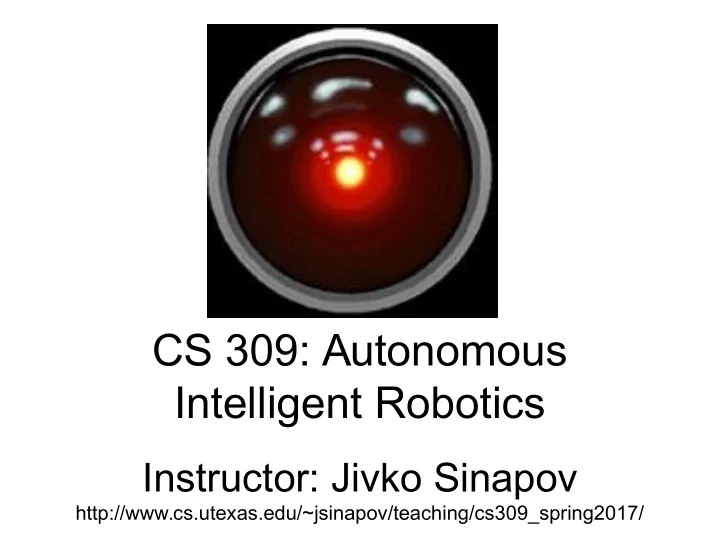

CS 309: Autonomous Intelligent Robotics Instructor: Jivko Sinapov http://www.cs.utexas.edu/~jsinapov/teaching/cs309_spring2017/
Reading Discussion
Announcements
Readings For This Week Bobick, Aaron F. "Movement, activity and action: the role of knowledge in the perception of motion." Philosophical Transactions of the Royal Society of London B: Biological Sciences 352.1358 (1997): 1257-1265. Poppe, Ronald. "A survey on vision-based human action recognition." Image and vision computing 28.6 (2010): 976-990. Frintrop, Simone, et al. "Computational visual attention systems and their cognitive foundations: A survey." ACM Transactions on Applied Perception (2010): 6.
Discussion Bobick, Aaron F. "Movement, activity and action: the role of knowledge in the perception of motion." Philosophical Transactions of the Royal Society of London B: Biological Sciences 352.1358 (1997): 1257-1265.
Discussion “I think that it can be hard to label some movements as just actions or activities. Perhaps it varies from context to context, and maybe different industries or disciplines have different divisions of movements than others. Can we expect one system to accurately detect actions for all contexts?” - Mayuri
Discussion “I can vaguely draw an analogy to the camera being able to register when a bowl is picked up but not hypothesize at what will happen next with the bowl. In other words, the camera has no intuition in regards to what is happening next in the visual sequence. The next logical question from this is, why should it be able to? What reason could people possible have for programming machines with this ability?” - Raychel
Discussion “What is a Hidden Markov Model (HMM)?” - Jeremy
Markov Chains
Markov Chains State Transition Matrix [ ] 0.9 , 0.075 , 0.025 0.15 , 0.8 , 0.05 0.25 , 0.25 , 0.5
Markov Chains Observation Bull Bear Bear Stag. Bull Bear . . . . . .
Hidden Markov Models Real Coin: Fake Coin: P( “head” ) = 0.5 P( “head” ) = 0.1 P( “tail” ) = 0.5 P( “tail” ) = 0.9
Hidden Markov Models Real Coin: Fake Coin: P( “head” ) = 0.5 P( “head” ) = 0.1 P( “tail” ) = 0.5 P( “tail” ) = 0.9 R R R F F F F R H T H T T T H T
Hidden Markov Models Real Coin: Fake Coin: P( “head” ) = 0.5 P( “head” ) = 0.1 P( “tail” ) = 0.5 P( “tail” ) = 0.9 ? ? ? ? ? ? ? ? H T H T T T H T
Hidden Markov Models State Transition Matrix: Observation Probability Matrix: [ ] “Real” “Fake” 0.9 , 0.1 0.2 , 0.8 0.5 0.1 0.5 0.9 ? ? ? ? ? ? ? ? H T H T T T H T
Discussion Poppe, Ronald. "A survey on vision-based human action recognition." Image and vision computing 28.6 (2010): 976-990.
Discussion “the author mentions that [...] the methods involved ignore the environmental context. This leads me to wonder - how much work has gone into contextualizing actions? For example, going beyond saying "two people running" and saying "a parent is chasing after a child"?” - Stone
Discussion “Combined with the array of sensors it has and its mobility, why aren't the BWIBots able to extrapolate 3D models from the environment? Does processing 3D data take too long, and if so, why can we not simply use approximation algorithms to circumvent this?” - Matthew
Discussion “I had another question on the topic of parsing out background information. Is it not possible to combine visual cameras with, say a LiDAR sensor to determine the distance away from objects in order to find where close objects are, and remove objects from the visual information that are far away (in the background)?” - Stone
Readings for Next Week
Readings for next week Alex Smola and S.V.N. Vishwanathan, Introduction to Machine Learning, Chapter 1, Cambridge University Press, 2008
Readings for this week In addition, this week, you get to pick a published, peer-reviewed conference or journal article. Your reading response should be about your pick.
Robotics and AI Conferences • IEEE International Conference on Robotics and Automation (ICRA) • IEEE International Conference on Intelligent Robots (IROS) • IEEE International Conference on Development and Learning (ICDL) • Robotics Science and Systems (RSS)
Robotics and AI Conferences (con't) • ACM / IEEE International Conference on Human-Robot Interaction (HRI) • International Conference on Social Robotics (ICSR) • AAAI Conference on Artificial Intelligence (AAAI) • International Joint Conference on Artificial Intelligence (IJCAI)
Robotics Journals • IEEE Transactions on Robotics (TRO) • IEEE Transactions on Autonomous Mental Development (TAMD) • International Journal of Robotics Research (IJRR) • Robotics and Autonomous System (RAS)
A brief tour of google scholar
In-class Activity Meet up with your group and find 2-3 articles in peer-reviewed conferences and journals that are relevant to your project ~10 minutes
High-Level Robot Actions • Go to a door • Go inside a location (e.g., an office) • Go to an “object”
THE END
Recommend
More recommend